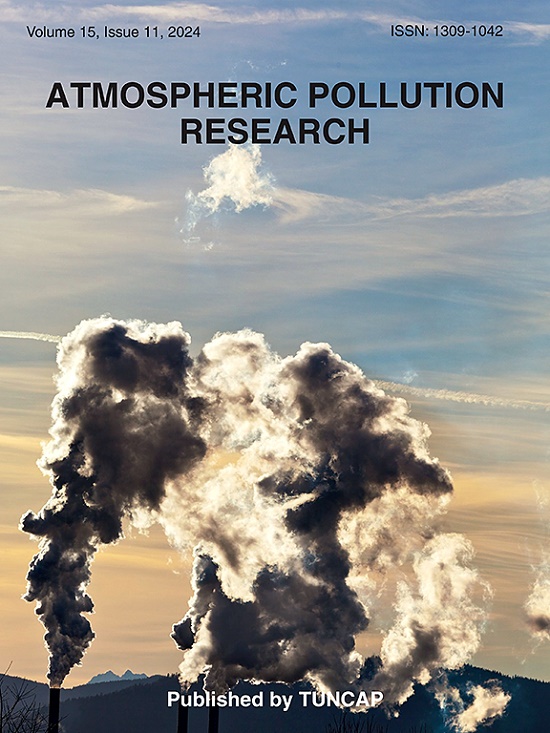Effect of ventilation settings on the in-car PM concentrations and the associated health risks in Kanpur, India
IF 3.5
3区 环境科学与生态学
Q2 ENVIRONMENTAL SCIENCES
引用次数: 0
Abstract
This study examines the seasonal variations in air quality within a car cabin under four different ventilation settings: (1) windows open (WO), (2) windows closed with air conditioning on and recirculation enabled (AC RC on), (3) windows closed with air conditioning on but recirculation disabled (AC RC off), and (4) windows closed with the fan off (Fan off). Additionally, the associated health risks were calculated using the ICRP method. A total of 120 trips were conducted on two different routes across two seasons (winter and summer) to monitor PM2.5 (fine particulate matter <2.5 μm) and PM10 (coarse particulate matter <10 μm) concentrations. A portable laser air quality sampler was used to measure PM concentrations and identify factors influencing air quality within the car cabin. The results indicate that the WO setting had the highest PM2.5 concentration (197.6 μg/m3) and deposition dose (1.53 μg/min), followed by the AC RC off setting (124.9 μg/m3, 1.04 μg/min), the Fan off setting (114.4 μg/m3, 0.88 μg/min), and the AC RC on setting (87.4 μg/m3, 0.69 μg/min). PM concentrations in winter were observed to be three to four times higher than in summer under all ventilation settings. Key factors influencing exposure levels include ventilation rates, traffic conditions, meteorological parameters, and surrounding environments. The dominance of PM suggests that conventional car filters are ineffective in removing them, thereby need for improved filtration systems. These findings provide valuable insights for commuters making informed ventilation choices and policymakers for developing strategies to improve in-car air quality.
印度坎普尔通风设置对车内PM浓度及相关健康风险的影响
本研究考察了四种不同通风设置下车厢内空气质量的季节性变化:(1)打开窗户(WO),(2)打开空调并开启再循环(打开AC RC)时关闭窗户,(3)打开空调但关闭再循环(关闭AC RC)时关闭窗户,以及(4)关闭风扇(关闭风扇)时关闭窗户。此外,使用ICRP方法计算相关的健康风险。在冬季和夏季两个季节,在两条不同的路线上共进行了120次旅行,以监测PM2.5(细颗粒物<;2.5 μm)和PM10(粗颗粒物<;10 μm)浓度。采用便携式激光空气质量采样器测量了汽车舱内的PM浓度,并确定了影响空气质量的因素。结果表明:WO设置PM2.5浓度最高(197.6 μg/m3),沉积剂量最高(1.53 μg/min),其次是AC RC设置(124.9 μg/m3, 1.04 μg/min),风机设置(114.4 μg/m3, 0.88 μg/min), AC RC设置(87.4 μg/m3, 0.69 μg/min)。在所有通风条件下,冬季PM浓度均比夏季高3 ~ 4倍。影响暴露水平的关键因素包括通风率、交通状况、气象参数和周围环境。PM的主导地位表明,传统的汽车过滤器在去除它们方面是无效的,因此需要改进过滤系统。这些发现为通勤者做出明智的通风选择和政策制定者制定改善车内空气质量的策略提供了有价值的见解。
本文章由计算机程序翻译,如有差异,请以英文原文为准。
求助全文
约1分钟内获得全文
求助全文
来源期刊

Atmospheric Pollution Research
ENVIRONMENTAL SCIENCES-
CiteScore
8.30
自引率
6.70%
发文量
256
审稿时长
36 days
期刊介绍:
Atmospheric Pollution Research (APR) is an international journal designed for the publication of articles on air pollution. Papers should present novel experimental results, theory and modeling of air pollution on local, regional, or global scales. Areas covered are research on inorganic, organic, and persistent organic air pollutants, air quality monitoring, air quality management, atmospheric dispersion and transport, air-surface (soil, water, and vegetation) exchange of pollutants, dry and wet deposition, indoor air quality, exposure assessment, health effects, satellite measurements, natural emissions, atmospheric chemistry, greenhouse gases, and effects on climate change.
 求助内容:
求助内容: 应助结果提醒方式:
应助结果提醒方式:


